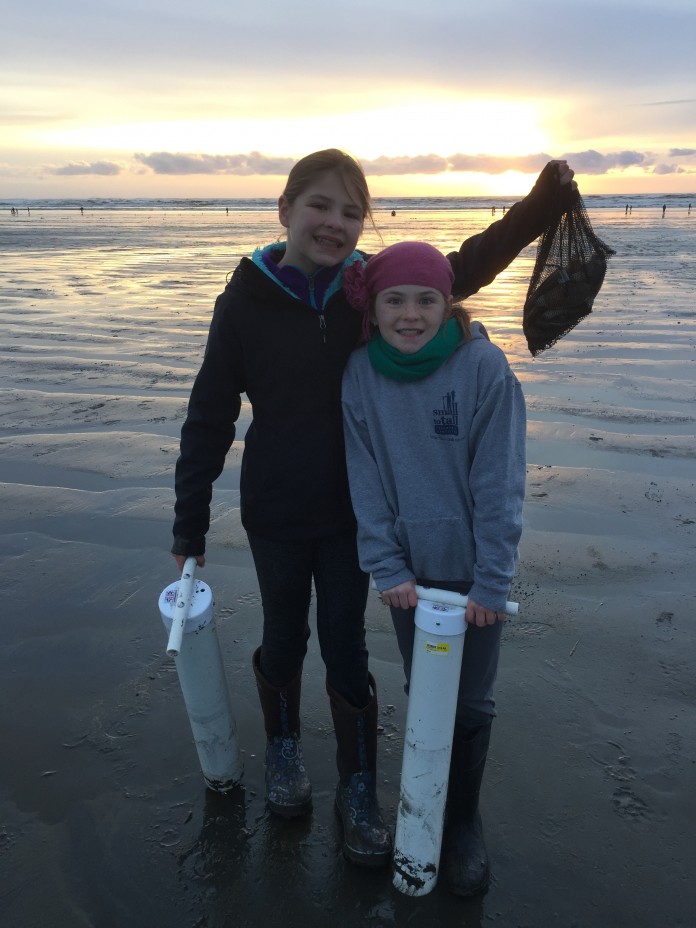Submitted by The Washington Department of Fish and Wildlife
State shellfish managers today approved nine days of razor clam digging beginning April 20 on the first of three ocean beaches.
The Washington Department of Fish and Wildlife (WDFW) approved the digs after marine toxin tests showed the clams on those beaches are safe to eat.
Dan Ayres, WDFW coastal shellfish manager, said the department added two days of digging at Copalis, which was not originally included in the list of tentative digs previously announced by the agency. The dig was added after catch estimates indicated that there are still clams available for harvest to allow for two weekday openings at the beach, he said.
Ayres recommends that diggers arrive at the beaches an hour or two before low tide for best results. However, digging is not allowed on any beach after noon.
The upcoming dig is scheduled on the following dates, beaches, and low tides:
- April 20, Wednesday, 6:25 a.m.; 0.6 feet; Long Beach
- April 21, Thursday, 7:01 a.m.; 0.2 feet; Long Beach
- April 22, Friday, 7:35 a.m.; 0.0 feet; Long Beach
- April 23, Saturday, 8:08 a.m.; -0.2 feet; Long Beach, Mocrocks
- April 24, Sunday, 8:42 a.m.; -0.2 feet; Long Beach
- April 25, Monday, 9:18 a.m.; -0.2 feet; Long Beach, Mocrocks, Copalis
- April 26, Tuesday, 9:56 a.m.; -0.1 feet; Long Beach, Mocrocks, Copalis
- April 27, Wednesday, 10:39 a.m.; 0.1 feet; Long Beach
- April 28, Thursday, 11:28 a.m.; 0.3 feet; Long Beach
Under state law, diggers are required to keep the first 15 clams they dig. Each digger’s clams must be kept in a separate container.
All diggers age 15 or older must have an applicable 2016-17 fishing license to harvest razor clams on any beach. Licenses, ranging from a three-day razor clam license to an annual combination fishing license, are available on WDFW’s website at https://www.fishhunt.dfw.wa.gov and from license vendors around the state.
Ayres notes that Twin Harbors Beach remains closed to razor clam digging due to elevated levels of domoic acid, a natural toxin produced by certain types of marine algae. Toxin levels at Twin Harbors are above the threshold (20 parts per million) set by public health officials.
Tentative razor clam dates in May 2016
Meanwhile, WDFW has also proposed additional digs in May, pending the results of future marine toxin tests.
- May 6, Friday, 6:51 a.m.; -1.5 feet; Long Beach
- May 7, Saturday, 7:39 a.m.; -2.0 feet; Long Beach
- May 8, Sunday, 8:26 a.m.; -2.1 feet; Long Beach
Ayres said the department will consider adding digging days at Mocrocks in May after reviewing harvest levels from the April dig.
During all upcoming digs, state wildlife managers urge clam diggers to avoid disturbing snowy plovers and streaked horned larks by observing posted vehicle speed limits and avoiding nest sites. Both species nest in the soft, dry sand at Leadbetter Point on the Long Beach Peninsula.
The snowy plover is a small bird with gray wings and a white breast. The lark is a small bird with a pale yellow breast and brown back. Male larks have a black mask, breast band and “horns.” Both species are listed as “endangered” in the state and as “threatened” under the federal Endangered Species Act.
Copalis extends from the Grays Harbor north jetty to the Copalis River, including Ocean Shores, Oyhut, Ocean City and Copalis areas.
Mocrocks extends from the Copalis River to the southern boundary of the Quinault Reservation near the Moclips River, including Iron Springs, Roosevelt Beach, Pacific Beach and Moclips.
Long Beach extends from the Columbia River to Leadbetter Point and Seaview, Cranberry, Klipsan , Ocean Park and Oysterville area.

















































